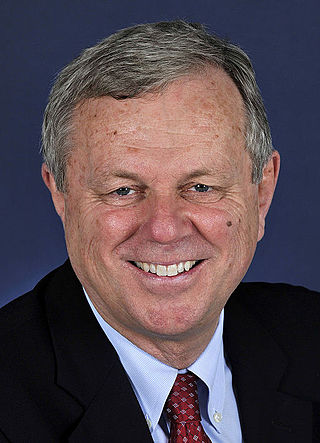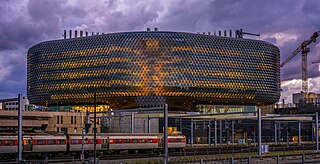
Adelaide is the capital city of South Australia, the state's largest city and the fifth-most populous city in Australia. "Adelaide" may refer to either Greater Adelaide or the Adelaide city centre. The demonym Adelaidean is used to denote the city and the residents of Adelaide. The Traditional Owners of the Adelaide region are the Kaurna people. The area of the city centre and surrounding Park Lands is called Tarndanya in the Kaurna language.

The University of Adelaide is a public research university located in Adelaide, South Australia. Established in 1874, it is the third-oldest university in Australia. The university's main campus is located on North Terrace in the Adelaide city centre, adjacent to the Art Gallery of South Australia, the South Australian Museum, and the State Library of South Australia.

The University of South Australia (UniSA) is a public research university in the Australian state of South Australia. It is a founding member of the Australian Technology Network of universities, and is the largest university in South Australia with approximately 37,000 students.

Westmead Hospital is a major teaching hospital in Sydney, Australia. Opened on 10 November 1978, the 975-bed hospital forms part of the Western Sydney Local Health District, and is a teaching hospital of Sydney Medical School at the University of Sydney.

The Women's and Children's Hospital (WCH) is a hospital dedicated to the care of women and children in Adelaide, South Australia. It was established in March 1989, when the Queen Victoria Hospital and Adelaide Children's Hospital were amalgamated, initially named Adelaide Medical Centre for Women and Children, being renamed to its present name in 1995.
A number of professional degrees in dentistry are offered by dental schools in various countries around the world.

North Terrace is one of the four terraces that bound the central business and residential district of Adelaide, the capital city of South Australia. It runs east–west, along the northern edge of "the square mile". The western end continues on to Port Road, and the eastern end continues across the Adelaide Parklands as Botanic Road.

The Royal Adelaide Show is an annual carnival and agricultural show run by the Royal Agricultural and Horticultural Society of South Australia. It is held at the Adelaide Showground, a dedicated venue located in Wayville, a suburb of Adelaide, South Australia.
SA Pathology,, is an organisation providing diagnostic and clinical pathology services throughout South Australia for the public health sector. The headquarters are in Frome Road, Adelaide, and it has many patient collection centres and numerous laboratories located throughout South Australia.

Jay Wilson Weatherill is a former Australian politician who was the 45th Premier of South Australia, serving from 21 October 2011 until 19 March 2018. Weatherill represented the House of Assembly seat of Cheltenham as a member of the South Australian Labor Party from the 2002 election to 17 December 2018, when he retired.

Flinders Medical Centre (FMC) is a major public tertiary hospital and teaching school, co-located with Flinders University and the 130 bed Flinders Private Hospital located at Bedford Park, South Australia. It opened in 1976. It serves as the trauma centre for the southern suburbs, and parts of the Adelaide Hills. An around-the-clock emergency retrieval service brings patients to FMC by road or helicopter.
The Lyell McEwin Hospital (LMH) is a major tertiary hospital located in Adelaide, South Australia that provides medical, surgical, diagnostic, emergency and support services to a population of more than 300,000 people living primarily in Adelaide's north and north eastern suburbs. It is affiliated with the University of Adelaide and the University of South Australia. It is named after Sir Lyell McEwin.
William Middleton Griggs, is a retired Australian physician specialising in trauma.
TheQueen Elizabeth Hospital (TQEH) is an acute care teaching hospital in the western suburbs of Adelaide, South Australia. It provides a range of health services, including inpatient, outpatient, surgical, emergency and mental health services.
Founded in 1965, the foundation's key role is to support the leading medical and health research conducted at The Queen Elizabeth Hospital and the Basil Hetzel Institute for Translational Health Research to improve the health of the South Australian community.

The Rann government was the state executive government of South Australia led by Premier of South Australia Mike Rann of the South Australian Branch of the Australian Labor Party (ALP) from 2002 to 2011.

The South Australian Health and Medical Research Institute (SAHMRI) is an independent health and medical research institute in Adelaide, South Australia. The institute is housed in a purpose-built eponymous building with its iconic "cheese-grater" design created by architects Woods Bagot, located in South Australia's health and biomedical precinct on North Terrace, just east of the Royal Adelaide Hospital.
Glenside Hospital, as it was known from 1967, previously the Public Colonial Lunatic Asylum of South Australia, Parkside Lunatic Asylum and Parkside Mental Hospital, was a complex of buildings used as a psychiatric hospital in Glenside, South Australia.
Maria Makrides is an Australian professor at the University of Adelaide who works on improving women and babies nutritional health. In 2019 she was made a fellow of the Australian Academy of Science. She is a professor of human nutrition at the Adelaide Medical School, and a theme leader for the South Australian Health and Medical Research Institute (SAHMRI) Women's and Children's Hospital.

Lot Fourteen is a business and technology precinct at the eastern end of North Terrace in Adelaide city centre, South Australia. The 7 ha (17-acre) site formerly accommodated the old Royal Adelaide Hospital, which was moved to a new building at the western end of North Terrace in 2017. Its name was derived from the original 1837 plan for Adelaide by surveyor-general Colonel William Light. By 2020, refurbished hospital buildings were home to a large number of tenants, and further new buildings and public spaces are planned, scheduled for completion around 2025. The redevelopment of the site has been led by the Department of the Premier and Cabinet.
















